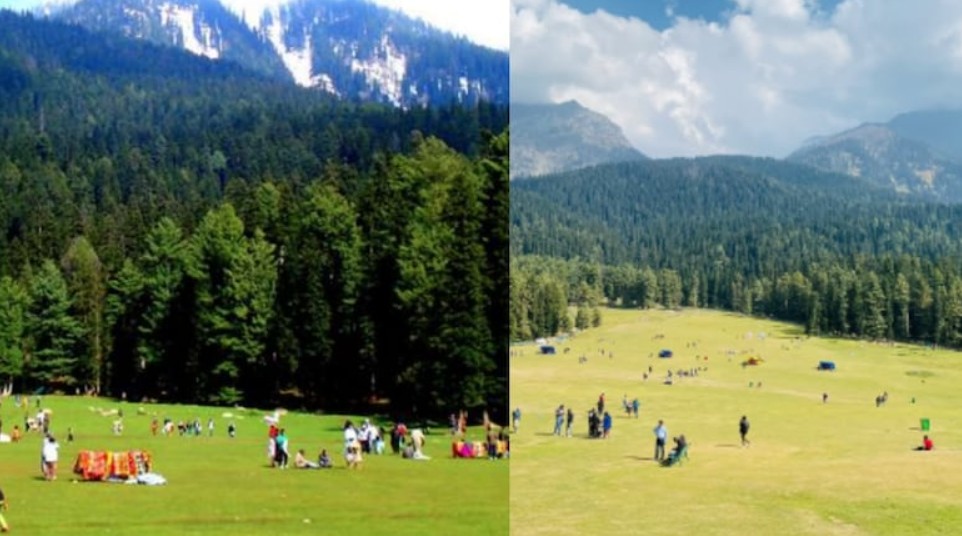
Pahalgam Terror Attack and India’s Tourism Challenge in J&K
The Pahalgam Terror Attack of April 22, 2025, marks a grim milestone in Kashmir’s troubled history. Baisaran Valley, a tourist haven surrounded by pine forests, became the site of India’s deadliest terror attack since the 2008 Mumbai siege. Twenty-six tourists, including two foreign nationals, lost their lives. Over 20 survivors now grapple with physical and emotional scars. The Pahalgam Terror Attack was the deadliest strike on civilians in Kashmir in two decades. This attack exposed systemic vulnerabilities in India’s tourist safety in Kashmir. How do we rebuild safety without compromising Kashmir’s soul? It is a wake-up call for a comprehensive blueprint for safer tourism in J&K.
Pahalgam Terror Attack: How the Tragedy Unfolded
On that fateful afternoon, five armed militants entered Baisaran meadows, targeting tourists enjoying the scenic landscape. The attackers used automatic weapons and created panic, making it difficult for anyone to escape. Survivors described scenes of chaos, bloodshed, and desperate attempts to find safety. The Pahalgam Terror Attack was carried out with chilling precision, with the victims being shot at point blank. Recounting the events that unfolded, close family members who were direct witnesses to this barbaric attack shudder at the very mention of it. With trauma writ large on their faces, moving on with life is easier said than done. Moreover, this event has deeply affected the sense of security in Kashmir’s tourist destinations.
Pahalgam Terror Attack – The Numbers
| Metric | Value | Source |
|---|---|---|
| Tourists killed | 26 | MHA Report |
| Injured | 20+ | J&K Police |
| Booking drop (April 2025) | 40% | Travel Association |
| Economic loss | ₹850 crore | Industry Estimates |
| PTSD (Post-Traumatic Stress Disorder) risk among survivors | 60%+ | NIMHANS Study |
Tourist Safety in Kashmir: From Broken Trust to Bold Reforms
Tourist safety in Kashmir demands more than checkpoints. Post-attack, 70% of hotel bookings were canceled, risking ₹1,200 crore in losses annually. Hoteliers and Shikara operators who invested life savings or sold land now face bankruptcy. Moreover, pony operators lost ₹50,000 in earnings, daily. To set things back on track, the government is coming out with a flurry of safety, economic and recovery reforms to assuage the confidence of both tourists and local businesses. The “Kashmir Tourist Shield” insurance (₹10 lakh medical costs coverage per visitor) is a positive start in this regard. Smart fencing, AI-powered drone grids, and emergency helipads in remote areas must become mandatory. Training locals as “Tourist Guardians” with ₹15,000 monthly stipends could turn communities into first responders. Tourist safety in Kashmir isn’t a policy-it’s a survival strategy.
Verified Statistics (2019–2025): The Data Behind the Crisis
| Metric | 2019 | 2023 | 2025 | Source |
|---|---|---|---|---|
| Tourist Arrivals | 1.8 million | 2.1 million | 1.9 million | J&K Tourism Dept |
| Terror Incidents | 594 | 189 | 45+ (till Apr) | South Asia Terrorism Portal |
| Economic Loss (Tourism) | ₹520 crore | ₹620 crore | ₹850 crore | CII Report |
| Foreign Tourists | 12,000 | 18,000 | 9,000 | MHA |
| Local Businesses Affected | 8,000+ | 10,000+ | 15,000+ | Kashmir Chamber of Commerce |
| 2025 data as of April 30, 2025. |
Counter-Terrorism Measures: Tech, Tactics, and Tenacity
Deploy drones with facial recognition across 50 high-risk zones by 2026. The ₹1,000 crore smart fencing project should integrate seismic sensors to detect tunnel digging. Counter-terrorism measures must also address radicalization through deprogramming camps and vocational training for at-risk youth. India can adapt these models:
- AI Surveillance: Deploy 5,000 cameras with gunshot detection and drones with thermal imaging to monitor 50 high-risk zones, including Gulmarg and Sonamarg.
- Community Alerts: GPS-enabled apps like Kashmir Safety Connect with real-time alerts and emergency aid., multilingual support for foreign tourists, and connects users to local authorities.
- Biometric Checkpoints: Hotels and transit hubs require ID verification linked to centralized databases.
- Community Training: Over 5,000 locals are being certified as “Tourist Guardians” to assist visitors and report threats.
- Army-Police Collaboration: Enhanced patrols and rapid response teams in tourist areas.
Global Lessons: How Other Nations Protect Tourists
After the 2015 Sousse attacks, Tunisia deployed 1,500 armed guards at beaches. Japan’s “Safe Tourism Cities” program uses AI to predict crowd risks. Counter-terrorism measures must outsmart evolving threats. Israel’s “Iron Dome” detects real threat for vulnerable areas. Singapore’s Sentosa Island offer lessons in AI-driven crowd management. Real-time threat detection and biometric checks can secure Kashmir’s hotspots. Counter-terrorism measures must blend global tech with local wisdom. India must adapt these models to its unique challenges. In addition, there should be partnerships with global safety organizations to adopt best practices.
Post-Attack Recovery Measures
| Initiative | Details | Timeline |
|---|---|---|
| AI Drones Deployed | 24/7 monitoring in 10 districts | Completed (2025) |
| Biometric Checkpoints | Installed at 200+ hotels | Phase 1 (2025) |
| Safety App Users | 50,000+ downloads | Since April 2025 |
| Tourist Guardians Trained | 2,500 certified | Ongoing |
Economic Support and Recovery Initiatives
The government announced a ₹500 crore relief package for tourism businesses affected by the Pahalgam Terror Attack. Low-interest loans, GST waivers, and insurance schemes are helping hotels, houseboats, and handicraft sellers recover. “Return to Kashmir” marketing campaigns are encouraging travelers to come back with special offers and discounts. The “Kashmir Tourist Shield” insurance now provides up to ₹10 lakh medical coverage for every visitor. Razing down the houses of terrorists in Anantnag and Pulwama districts is also a bold move. These steps are vital for the long-term stability of Kashmir’s tourism industry and the livelihoods of thousands of families.
Since the new measures began, major hotels have reopened with advanced security protocols. Adventure tourism agencies report a 30% increase in bookings since the upgrades. Most importantly, tourists are back to the state, especially Pahalgam, after the tourist ban was lifted on April 25th. The resilience of Kashmir’s people and businesses is restoring hope for a brighter, safer future. International travel advisories are being updated as confidence in security measures in Kashmir grows. Support from organizations like the World Tourism Organization and Indian travel associations is helping drive Kashmir tourism recovery. Collaborative efforts are making the region safer and more attractive for visitors from around the world. Supporting Green Tourism ventures in the region is another forward-looking step that the government can actively promote. These positive developments show that a strong blueprint for safer tourism in J&K can work.
Long-Term 10-Point Blueprint for Safer Tourism in J&K
- Tech-Driven Security: Expand AI surveillance, biometric checks, and GPS-enabled apps to all tourist hubs.
- Community Collaboration: Train more “Tourist Guardians” and strengthen partnerships between locals and authorities.
- Infrastructure Upgrades: Build emergency helipads, medical units, and clear evacuation routes in remote areas.
- Global Best Practices: Adopt international safety standards and collaborate with global tourism safety organizations.
- Awareness and Training: Distribute multilingual safety guides and conduct regular drills for tourists and staff.
- Diplomatic Offensive: Suspend trade with terror-sponsoring states; rally global allies.
- Economic Lifelines: GST waivers, ₹15,000 stipends for affected businesses.
- Mental Health: Trauma centers in all 10 tourist districts of J&K to provide mental health support and trauma care.
- Legal Teeth: Fast-track courts and asset freezes of all terror suspects and terror sponsors.
- Political Unity: All-party consensus on Kashmir’s security roadmap.
The Pahalgam Terror Attack must catalyze systemic change in ensuring fool-proof security in the valley. India’s blueprint must transform J&K into a model of secure, sustainable tourism, where terror finds no quarter.
Pahalgam Terror Attack and the Road Ahead
The Pahalgam Terror Attack was a tragedy that shook the nation and the world. It has forced a rethinking of how we protect visitors and support local communities in Kashmir. The new blueprint for safer tourism in J&K is built on technology, community resilience, and economic recovery. By focusing on tourist safety in Kashmir, strengthening security measures in Kashmir, and driving Kashmir tourism recovery, the region can once again welcome travelers with confidence. The lessons learned from the Pahalgam Terror Attack must guide all future efforts to ensure such a tragedy is never repeated.
Call to Action:
Share this blueprint, Stand with survivors, Demand action, Visit Kashmir.
#PahalgamTerrorAttack, #KashmirTourism, #VisitKashmir, #SupportLocalKashmir, #SaferTourism

Very well expressed.